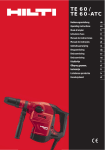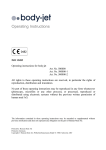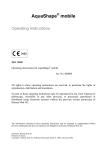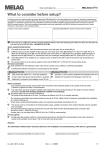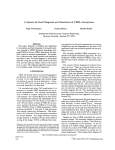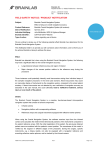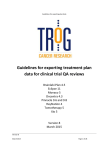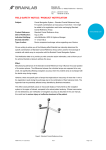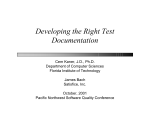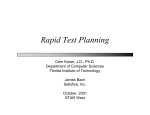Download S4 Cervical Navigated Instruments SOP-AIS
Transcript
Aesculap Spine Instructions for use/Technical description S4 Cervical - Navigated Instruments Gebrauchsanweisung/Technische Beschreibung S4 Cervical - Navigierte Instrumente Mode d’emploi/Description technique S4 Cervical - Instruments navigués Instrucciones de manejo/Descripción técnica S4 Cervical Instrumental de navegación Istruzioni per l’uso/Descrizione tecnica S4 Cervical - Strumenti navigati Instruções de utilização/Descrição técnica S4 Cervical - Instrumentos de navegação Gebruiksaanwijzing/Technische beschrijving S4 Cervical - genavigeerde instrumenten Brugsanvisning/Teknisk Beskrivelse S4 Cervical - Navigerede instrumenter Návod k použití/Technický popis Navigované nástroje S4 Cervical A B C D E F H G I K L M N O J Aesculap Spine S4 Cervical - Navigated Instruments Intended Use The S4C Navigation Instruments listed within are intended to assist the surgeon in locating anatomical structures in either open, minimally invasive, or percutaneous procedures. Indication and contraindications are specified in the instruction for use for implants (SOP-AIC-5000169). Legend Intended use Navigated screw tap ∅ 3.5 mm (FW655R) IGS Tool Star Unit (pre-calibrated) (Brainlab) (55830-20A) C Handle (FW165R with ratchet or FW067R without ratchet) D Navigated screwdriver for polyaxial screw (FW656R) E IGS Tool Star Unit ML (calibration with ICM4) (Brainlab) (55830-25A) F Navigated drill guide ∅ 3.5 mm, short (FW654R) G Aesculap star unit Navigation attachment (FW652R) H Navigated guide sleeve ∅ 4.0 mm for smooth-shank screws (FW658R) I Reduction sleeve ∅ 13 mm for Brainlab Instrument Calibration Matrix Rev. 4 (FW657R) J Navigated guide sleeve ∅ 3.5/4.0 mm (FW660R) K C1/C2 inner sleeve guide ∅ 4 mm (FJ985R) L C1/C2 inner sleeve guide ∅ 3.5 mm (FW661R) M C1/C2 drill bit ∅ 2.4 mm (FW662SU) N C1/C2 screw tap ∅ 3.5 mm (FW663R) O Cortical punch for navigated drill guide FW654R (FW653R) A B Symbols on product and packages Symbol Explanation Sterilization using irradiation Not for reuse in intended applications as defined by the manufacturer Use by Caution, general warning symbol Caution, see documentation supplied with the product Date of manufacture 4 Cervical The Navigation Instruments areisindicated use in cervical surgicaland spinal The SS4C System (S4C System) used for for posterior thoprocedures, in which use ofIndications stereotactic surgery may be appropriate, racic stabilisation andthe fusion. and contraindications are specand to afor rigid structure , suchThe as instruments the pelvis or ifiedwhere in thereference instructions useanatomical for implants (TA011796). a vertebrae can be identified relative to the acquired image (CT, MR, 2D listed in the captions form part of this system. They are used and/or for thean indifluoroscopic image or 3D fluoroscopic image reconstruction) 4 C implantsinclude in patients. vidual data adaptation, positioning insertion of Sprocedures image based model of the and anatomy. These but For not safelimited usage,to follow instructions for S4CofSystem are spinal fusion duringfor theuse navigation pedicleInstruments screws (T1T3). (TA011984) and Operating Technique (O34202). The instruments listed in the captions may only be used with the Brainlab navigation system. For safe handling prior to the operation, read Spine & Trauma user manual for Brainlab instruments and the corresponding software manual for the Brainlab spine application used. Combination specifications Aesculap and Brainlab accept absolutely no responsibility if instruments, awls or drills other than those named below are used with the corresponding drill guides and guide sleeves. • Only combine S4C navigated drill guide F with: – S4C-cortical punch for S4C-drill guide O – Standard drill bit, ∅ 2.4 mm for ∅ 3.5 mm screws (FW051SU) • Only combine S4C navigated guide sleeve ∅ 4.0 mm H for smoothshank screws with: – Smooth-shank screw bone awl (FW085R) – Smooth-shank screw drill (FW086SU) – Smooth-shank screw tap (FW087R) – Polyaxial screwdriver (FW070R) – Navigated screwdriver for polyaxial screw (FW656R) – Apfelbaum ball end screwdriver, short (FJ968R) • Only combine S4C navigated guide sleeve ∅ 3.5/4.0 mm J with: – approved Apfelbaum C1/C2 obturator (FJ983R) – Apfelbaum trocar (FJ984R) – Favored Angle screw drill ∅ 2.9 mm for ∅ 4 mm screws (FW088SU) – Favored Angle screw tap ∅ 4 mm (FW089R) – C1/C2 inner sleeve guide ∅ 4 mm K (FJ985R) – S4C Favored Angle screwdriver (FW069R) – C1/C2 drill bit ∅ 2.4 mm for ∅ 3.5 mm screws (FW662SU) M – C1/C2 screw tap ∅ 3.5 mm (FW663R) N – C1/C2 inner sleeve guide ∅ 3.5 mm (FW661R) L – Apfelbaum ball end screwdriver (FJ988R) Note K-wires generally may not be used with the S4C system. 2 Safe handling and preparation CAUTION Federal law restricts this device to sale by or on order of a physician! WARNING Risk of injury caused by incorrect operation of the product! ¾ Attend appropriate product training before using the product. ¾ For information regarding such training, please contact your national B. Braun/Aesculap agency. ¾ Ensure that the product and its accessories are operated and used only by persons with the requisite training, knowledge, or experience. ¾ Read, follow, and keep safe the instructions for use. ¾ Use the product only in accordance with its intended use, see Intended use. ¾ Remove the transport packaging and thoroughly clean the new product, either manually or mechanically, prior to its initial sterilization. ¾ Store any new or unused products in a dry, clean, and safe place. ¾ Prior to each use, inspect the product for loose, bent, broken, cracked, worn, or fractured components. ¾ Do not use the product if it is damaged or defective. Set aside the product if it is damaged. ¾ Replace any damaged components immediately with original spare parts. ¾ To avoid damage to the working end: Carefully insert the product through the working channel (e.g. trocar). ∅ S4C1/C2 drill bit 2.4 mm (FW662SU), standard drill ∅ 2.4 mm (FW051SU), Favored Angle screw drill ∅ 2.9 mm (FW088SU) and drill ∅ 2.9 mm for smooth-shank screws (FW086SU) DANGER ¾ Prior to each use, inspect the product for loose, bent, broken, cracked or fractured components. ¾ Do not use the product if it is damaged or defective. Set aside the product if it is damaged. ¾ Do not use the product after expiry of its use-by date. Safe operation WARNING Risk of injury and/or malfunction! ¾ Always carry out a function check prior to using the product. Risk of injury to the patient! WARNING WARNING WARNING Risk of infection of patients and/or users and impairment of product functionality due to reuse. Risk of injury, illness or death due to contamination and/or impaired functionality of the product! ¾ Do not reuse the product. ¾ Handle S4C instruments with the greatest of care as they are extremely precise and highly sensitive. ¾ Check accurate calibration of dropped or damaged S4C instruments, or send them to the Aesculap Technical Service. Risk of injury to the patient! ¾ Prior to the operation, plan the configuration of the operating room, the assembly of the instruments and the alignment of the reference star. ¾ Ensure that the navigation camera has an unrestricted view on the reflective marker spheres of the instruments. Risk of injury to the patient! ¾ Ensure that the instruments used are not bent or damaged. ¾ Before use, check the precision of the instruments, particularly that of fine instruments. For this, hold the instrument tip in the pivot point of the Brainlab Instrument Calibration Matrix Rev. 4. Risk of injury to the patient! The product is gamma-sterilized and ships in sterile packaging. The product must not be reused. ¾ Ensure that the product and its accessories are operated and used only by persons with the requisite training, knowledge, or experience. ¾ Read, follow, and keep safe the instructions for use. ¾ Use the product only in accordance with its intended use, see Intended use. ¾ Do not use products from open or damaged sterile packaging. WARNING ¾ Use navigated S4C instruments only with Brainlab disposable reflective marker spheres. Note For further information on the correct handling of the marker spheres, see corresponding Brainlab user manual. 3 Aesculap Spine S4 Cervical - Navigated Instruments Preparing holes for S4C screws with navigation Risk of injury to the patient! ¾ Observe the combination specifications WARNING To center punch the screw holes in the cortical layer for the self-tapping S4C screws ∅ 3.5 mm with navigation, use the S4C navigated drillguide ∅ 3.5 mm F only together with S4C cortical punch for S4C navigated drill guide O. To center punch screw holes in the cortical layer without navigation, see instructions for use S4 Cervical Instruments (TA011984). WARNING Risk of damage to the spinal cord, nerve roots, adjacent intervertebral space or soft tissue when inserting the cortical punch without drill guide! ¾ Use the cortical punch only with drill guide FW654R. ¾ Mount the Brainlab reflective marker spheres 4 onto Aesculap star unit G, see Brainlab user manual. ¾ Retract and hold locking sleeve 1 of the Aesculap star unit G against the spring pressure in the direction of the arrow. ¾ Push Aesculap star unit G onto adapter 2 of the S4C drill guide F. When doing so, ensure that the pin of the adapter 3 engages in the recess on the star unit. ¾ Release locking sleeve 1. DANGER Risk of injury from an incorrectly placed hole or a hole that is too deep! ¾ Do not sharpen the drill, as this would cause imprecise or incorrect readings on the depth gauge. ¾ Replace blunt drills with new ones. The drill is applied with a S4C drill guide and drilled in either manually with the drill handle (FJ839R) or with a motor system with the Aesculap Intrahandpiece (e.g. GD450R/GD456R). Risk of damage to the spinal cord, nerve roots, adjacent intervertebral space or soft tissue through incorrect drilling! DANGER F 4 5 O 6 Fig. 1 Mounting the Aesculap star unit on S4C drill guide FW654R 4 Drilling holes for the S4C screws Assembling the drill and drill handle (for manual drilling only) G 1 2 3 ¾ Prior to each use, check the instrument with the Brainlab Instrument Calibration Matrix Rev. 4, see Brainlab user manual. ¾ Before using for the first time and before every 10th use, carry out a validation of the instrument with the Brainlab Instrument Calibration Matrix Rev. 4, see Brainlab user manual. Ensure that the cortical punch O for navigated drill guide is removed. ¾ To ensure the camera has an unrestricted view on the reflective marker spheres, unscrew knob 6 on the S4C handle of the S4C drill guide F and turn the Aesculap star unit G to the desired position. ¾ Once the desired position is reached, tighten knob 6 again. ¾ Adjust the center punch depth by turning the depth stop 5 on the S4C drill guide F. The maximum depth is 6 mm. ¾ Insert S4C cortical punch O into S4C drill guide F. ¾ Check the pre-set center punch depth with a caliper (e.g. AA845R). ¾ To open the cortical bone, press S4C cortical punch to the preset depth under control with the Brainlab navigation system. ¾ Use only the correct S4C drill guides to drill holes. Insert drill only with the correct drill guide. ¾ Before drilling, the pre-set drill length must be checked with a caliper (e.g. AA845R, Caspar instrument for anterior cervical fusion). DANGER Injury to spinal cord and nerve roots caused by application of a drill that is too long! ¾ Use the X-ray image to select an appropriate drill length prior to the operation. ¾ The drill may only be aligned and inserted under radiographic control and/or with the aid of a navigation system. ¾ Select a drill of a length equivalent to the intended drill hole depth. ¾ Insert drill in the drill handle (FJ839R), see Fig. 2. ¾ Retract and hold locking sleeve against the spring pressure in the direction of the arrow. ¾ Push the drill into the receptacle of the drill handle as far as it will go. ¾ Slightly rotate the drill and release locking sleeve. The drill engages audibly, see Fig. 2. To drill the holes for the screws with ∅ 4 mm, use standard drill guide FW053R without navigation, see instructions for use for S4 Cervical Instruments (TA011984). ¾ Mount the Brainlab reflective marker spheres 4 onto Aesculap star unit G, see Brainlab user manual. ¾ Retract and hold locking sleeve 1 of the Aesculap star unit G against the spring pressure in the direction of the arrow. ¾ Push Aesculap star unit G onto adapter 2 of the S4C drill guide F. When doing so, ensure that the pin of the adapter 3 engages in the recess on the star unit. ¾ Release locking sleeve 1. 1 2 3 G F 4 5 Click Fig. 2 Assembling the drill DANGER Risk of injury and/or damage to the drill if the drill rotation speed is too high! ¾ Use the lowest drilling speed possible, so that you can control the drilling depth. ¾ Do not bend the drill during the drilling process. Drilling holes for S4C screws ∅ 3.5 mm Risk of injury to the patient! ¾ Observe the combination specifications WARNING For controlled drilling of the holes for S4C-screws ∅ 3.5 mm with standard drill ∅ 2.4 mm (FW051SU), the S4C navigated drill guide ∅ 3.5 mm F (FW654R) must always be used. Note The drill ∅ 2.9 mm (FW052SU) may not be used with S4C navigated drill guide F. 6 Fig. 3 Mounting the Aesculap star unit on S4C drill guide FW654R ¾ Prior to each use, check the instrument with the Brainlab Instrument Calibration Matrix Rev. 4, see Brainlab user manual. ¾ Before using for the first time and before every 10th use, carry out a validation of the instrument with the Brainlab Instrument Calibration Matrix Rev. 4, see Brainlab user manual. Ensure that the drill FW051SU is removed. ¾ To ensure the camera has an unrestricted view on the reflective marker spheres, unscrew knob 6 on the handle of the S4C drill guide F and turn the Aesculap star unit G to the desired position, see Fig. 1. ¾ Once the desired position is reached, tighten knob 6 again. ¾ Adjust the drill depth by turning the depth stop 5 on the S4C drill guide F. ¾ Insert the drill with mounted handle or Intra-handpiece into S4C drill guide F. ¾ Before drilling, the pre-set drill length must be checked with a caliper (e.g. AA845R, Caspar instrument for anterior cervical fusion). ¾ Drill to the pre-set depth under control with the Brainlab navigation system. 5 Aesculap Spine S4 Cervical - Navigated Instruments Tapping (optional) S4C screws are self-tapping. However, if the bone quality is found to be hard during the operation, the surgeon can also pre-tap the thread with the S4C screw tap. ¾ For navigated tapping of the drill holes for screws ∅ 3.5 mm, use S4C navigated screw tap A. ¾ For tapping the drill holes for screws ∅ 4 mm, use the standard screw tap without navigation (FW047R), see TA011984. Risk of tissue injury when using the S4C screw tap (A) and damage to bone thread! 4C ¾ Prior to using the S screw tap, ensure that the moveable sleeve of the screw tap retracts correctly. DANGER ¾ To tap the thread, hold the IGS Tool Star Unit B at the planned indentations with one hand, and with the other hand screw in S4C handle C slowly and steadily under control with the Brainlab navigation system, until the required depth is reached. ¾ Use the scale behind the retractable sleeve of the S4C screw tap to read the depth during the tapping process, see Fig. 5. A Fig. 5 Screw tap with readable thread depth Positioning S4C screw under navigation and temporarily fixing it in place Risk of injury to the patient! ¾ Mount the Brainlab reflective marker spheres 4 onto the IGS Tool Star Unit B (pre-calibrated), see Brainlab user manual. ¾ Push the IGS Tool Star Unit onto the shaft 7 of the S4C navigated screw tap A. Ensure that the star unit is securely fitted onto the shaft of the S4C screw tap. Note The star unit can be rotated on the shaft of the S4C screw tap. ¾ ¾ ¾ ¾ Retract and hold locking sleeve 8 against the spring pressure. Attach S4C handle (FW067R or FW165R) to S4C navigated screw tap A. Push S4C handle onto the shaft of the S4C navigated screw tap A. Release locking sleeve 8, see Fig. 4. Check that the S4C handle is engaged. B A B 4 C 7 9 8 Fig. 4 Mounting the IGS Tool Star Unit and S4C handle onto the S4C screw tap WARNING Risk of injury to the patient! ¾ Before use, ensure that the selected instrument has been correctly assembled. ¾ Ensure that the arrow on the underside of the IGS Tool Star Unit (pre-calibrated) is pointing to the tip of the tool. ¾ Prior to each use, check the instrument with the Brainlab Instrument Calibration Matrix Rev. 4, see Brainlab user manual. ¾ Before using for the first time and before every 5th use, carry out a validation of the instrument with the Brainlab Instrument Calibration Matrix Rev. 4, see Brainlab user manual. 6 ¾ Use S4C screwdriver only with IGS Tool Star Unit ML for manual calibration. ¾ If you change screws, perform the calibration again. DANGER ¾ To position S4C screws ∅ 3.5 mm and ∅ 4 mm under navigation, use S4C navigated screwdriver D. ¾ Mount the Brainlab reflective marker spheres 4 onto IGS Tool Star Unit ML E, see Brainlab user manual. ¾ Push the IGS Tool Star Unit ML E onto the shaft 10 of the S4C screwdriver D. Ensure that the star unit is securely fitted onto the shaft of the S4C screwdriver. Note The star unit can be rotated on the shaft of the S4C screwdriver. ¾ ¾ ¾ ¾ Retract and hold locking sleeve 8 against the spring pressure. Mount S4C handle (FW067R or FW165R) onto S4C screwdriver D. Push S4C handle onto the shaft of S4C screwdriver D. Release locking sleeve 8, see Fig. 6. Check that the S4C handle is engaged. E D 4 C E 10 8 Fig. 6 Mounting the IGS Tool Star Unit and S4C handle (FW067R or FW165R) onto the S4C screwdriver Note The S4C screwdriver is fitted with a self-retaining function to prevent the S4C screw from falling off when it is passed to the surgeon. ¾ Retract and hold holding sleeve 12 on the S4C screwdriver D. ¾ Insert the tip of the S4C screwdriver D fully into the hexagon of the screw 11. ¾ Release holding sleeve 12. Ensure that the screw 11 is securely in place on the S4C screwdriver D and that the polyaxiality of the screw 11 is blocked. E D C 11 12 Fig. 7 Picking up the DANGER S4C screw with the S4C screwdriver Risk of injury to the patient! ¾ Before use, ensure that the selected instrument has been correctly assembled. ¾ Ensure that the arrow on the underside of the IGS Tool Star Unit ML is pointing to the tip of the tool. ¾ Prior to using the instrument with the correctly held screw, perform manual calibration with the Brainlab Instrument Calibration Matrix Rev. 4, see Brainlab user manual. ¾ Screw in the screw under control with the Brainlab navigation system. When doing so, hold IGS Tool Star Unit ML at the planned indentations with one hand, and turn the S4C handle C to screw in the screw 11 with the other hand. DANGER Serious complications for the patient can be caused by incorrect positioning of instruments or implants! ¾ Carry out operative steps with radiographic visualization. ¾ When removing the smooth-shank screw awl (FW085R) and during the further operating steps, ensure that the S4C navigated smoothshank screw guide sleeve remains securely fixed in place. ¾ Ensure that the window on the S4C navigated smooth-shank screw guide sleeve is closed during the preparation of the screw hole and while the screw is being inserted, see laser marking on the inner sleeve. ¾ Take care that no tissue gets caught when opening and closing the window on the S4C navigated smooth-shank screw guide sleeve, after the screw has been put in place. ¾ Mount the Brainlab reflective marker spheres 4 onto the Aesculap star unit G, see Brainlab user manual. ¾ Retract and hold locking sleeve 1 against the spring pressure in the direction of the arrow. ¾ Push Aesculap star unit G onto adapter 2. When doing so, ensure that the recess on the star unit is seated over the pin 3 of the adapter. ¾ Release locking sleeve 1. 1 2 3 G H Smooth-shank screw instruments G Risk of injury to the patient! ¾ Observe the combination specifications 4 13 WARNING Instruments for smooth-shank screws are marked with a light-blue ring. They are used to center punch, drill and tap holes for smooth-shank screws ∅ 4 mm. 14 6 Fig. 8 Mounting the Aesculap star unit on the S4C guide sleeve for smooth-shank screws. 7 Aesculap Spine S4 Cervical - Navigated Instruments DANGER Risk of injury to the patient! ¾ Slide reduction sleeve into the Brainlab Instrument Calibration Matrix Rev. 4, until you hear an audible click. ¾ Prior to each use, check the instrument with special reduction sleeve I with the Brainlab Instrument Calibration Matrix Rev. 4, see Brainlab user manual. ¾ Before using for the first time and before every 10th use, carry out a validation of the instrument with reduction sleeve I with the Brainlab Instrument Calibration Matrix Rev. 4, see Brainlab user manual. Ensure that all other instruments (awl, drill, screw tap etc.) are removed for the instrument validation. I ¾ Insert the smooth-shank screw tap into the inner sleeve and slowly and steadily screw in until the desired depth. When doing so, read the thread depth on the screw tap scale. ¾ Remove smooth-shank screw tap from the operating field. Note If the S4C screw with S4C screwdriver FW656R is planned to be inserted under navigation with the guide sleeve H, remove the Aesculap star unit on the S4C guide sleeve for smooth-shank screws. Risk of injury to the patient! DANGER ¾ The navigated S4C screwdriver FW656R or other screwdrivers are only intended for navigation in the non-navigated S4C guide sleeve FW658R. ¾ Navigate the S4C screwdriver FW656R, see positioning S4C screw under navigation and temporarily fix it in place. Fig. 9 Reduction sleeve for validation/verification with the Brainlab Instrument Calibration Matrix Rev. 4 ¾ To ensure the camera has an unrestricted view of the reflective marker spheres, unscrew knob 6 on the S4C handle of the S4C guide sleeve H and turn the Aesculap star unit G to the desired position, see Fig. 8. ¾ Once the desired position is reached, tighten knob 6 again. ¾ Place S4C guide sleeve H for smooth-shank screws in the operating field. When doing so, ensure that the window of the guide sleeve is closed during the preparation and insertion of the screw with the guide sleeve, see laser marking on the inner sleeve 13. ¾ Center punch the cortical layer of the vertebral body with the smoothshank screw awl (FW085R), see TA011984. ¾ If necessary, insert the awl into the inner sleeve 13 and center punch the bone as far as the stop-position. The stop-position is indicated with a marking on the awl. ¾ Remove the awl from the operating field. ¾ Insert the smooth-shank screw drill (FW086SU) 14 with mounted handle (FJ839R) or Intra-handpiece into the inner sleeve 13. ¾ Before drilling, the pre-set drill length must be checked with a caliper (e.g. AA845R, Caspar instrument for anterior cervical fusion). ¾ Under control with the Brainlab navigationssystem, drill a hole in the bone until the adjustable stop-position is reached. For further information on drilling, see instructions for use for S4 Cervical Instruments (TA011984). ¾ Remove the drill from the operating field. ¾ To prepare the drill holes for the screws, tap the thread with the smooth-shank screw tap (FW087R). 8 DANGER Risk of injury to the patient through freely rotating screws! ¾ Do not screw in screw so far that the screw head comes into contact with the S4C guide sleeve. Note Use navigated S4C screwdriver FW656R only with non-navigated S4C guide sleeve FW658R. ¾ Navigate S4C screwdriver, see Positioning S4C screw under navigation and temporarily fixing it in place. ¾ Insert the screw through the S4C guide sleeve but do not screw it in completely (smooth shank must remain free). Remove S4C screwdriver D from the operating field. ¾ Remove instrument from the screw: – Turn the blue inner sleeve 13 and open the window on the S4C guide sleeve. – Carefully push away S4C guide sleeve H laterally from the screw. – Remove S4C guide sleeve H from the operating field. Instruments for Favored Angle screws Risk of injury to the patient! ¾ Observe the combination specifications WARNING Favored Angle instruments are marked with a gold-colored ring. DANGER Serious complications for the patient can be caused by incorrect positioning of instruments or implants! ¾ Carry out operative steps with radiographic visualization. ¾ When removing the obturator (FJ983R) and during the further operating steps, ensure that the S4C guide sleeve remains securely fixed in place. Drilling holes for Favored Angle screws ¾ Mount the Brainlab reflective marker spheres 4 onto Aesculap star unit G, see Brainlab user manual. ¾ Mount Aesculap star unit G onto S4C navigated guide sleeve ∅ 3.5/ 4.0 mm J. When doing so, retract and hold the locking sleeve 1 against the spring pressure in the direction of the arrow. ¾ Push Aesculap star unit G onto adapter 2 of the S4C guide sleeve J. When doing so, ensure that the recess is seated over the pin 3 of the adapter. ¾ Release locking sleeve 1. J 1 2 3 G 4 15 Note So as not to lose the entry opening, keep the drill in the drill hole, press the button 16 on the inner sleeve guide K and push down the guide sleeve until it reaches the stop on the bone surface. Then remove the drill and inner sleeve guide K from the S4C guide sleeve J. J K ¾ Prior to each use, check the instrument with the Brainlab Instrument Calibration Matrix Rev. 4, see Brainlab user manual. Ensure that the inner sleeve guide K is mounted prior to this check. ¾ Before using for the first time and before every 10th use, carry out a validation of the instrument with the Brainlab Instrument Calibration Matrix Rev. 4, see Brainlab user manual. Ensure that the inner sleeve guide K is mounted prior to this validation. ¾ To ensure the camera has an unrestricted view of the reflective marker spheres, unscrew knob 6 on the S4C handle of the S4C guide sleeve J and turn the Aesculap star unit G to the desired position, see Fig. 10. ¾ Once the desired position is reached, tighten knob 6 again. ¾ Then remove inner sleeve guide K again from the S4C guide sleeve J. ¾ Slide obturator (FJ983R) into the inner sleeve 15 of the S4C guide sleeve J. The obturator engages in the inner sleeve and can still be rotated. ¾ Bring S4C guide sleeve J with mounted obturator into the operating field through the stab incision and position it in place. ¾ Press the button 16 on the obturator (FJ983R) and withdraw the obturator from the inner sleeve 15. ¾ If necessary, slide Apfelbaum trocar (FJ984R) into the inner sleeve 15 and insert into the bone to center punch the screw entry point. ¾ Remove the trocar from the operating field. ¾ Push inner sleeve guide K onto the inner sleeve 15. The inner guide sleeve engages on the inner sleeve and can still be rotated, see Fig. 10. ¾ Insert drill for Favored Angle screws (FW088SU) with mounted handle (FJ839R) or Intra-handpiece into the inner sleeve guide K. ¾ Drill to the pre-set depth under control with the Brainlab navigation system. The drill depth can be read on the scale on the inner sleeve guide K. For further information on drilling, see instructions for use for S4 Cervical Instruments (TA011984). 16 ¾ Press button 16 and remove the inner sleeve guide K from the inner sleeve 15. ¾ To prepare screw holes, insert the Favored Angle screw tap ∅ 4 mm (FW089R) into the inner sleeve 15 and tap. The drill depth can be read on the scale on the screw tap. ¾ Turn the screw tap counterclockwise until it almost exits the bone. 6 Fig. 10 Mounting the Aesculap star unit onto the S4C guide sleeve; inserting the S4C drill guide 9 Aesculap Spine S4 Cervical - Navigated Instruments Note So as not to lose the entry opening, turn the screw tap counterclockwise until it almost exits the bone. Then turn the inner sleeve 15 counterclockwise and at the same time push down the S4C guide sleeve J until it reaches the stop on the bone surface. After that, completely unscrew the Favored Angle tap ∅ 4 mm (FW089R) from the bone and together with the inner sleeve 15 remove it from the S4C guide sleeve J. Inserting the screw ¾ Ensure that the inner sleeve 15 has been removed from the S4C guide sleeve J by turning it counterclockwise. ¾ Pick up a suitable Favored Angle screw ∅ 4.0 mm with the self-retaining S4C screwdriver (FW069R). When doing so, retract and hold the holding sleeve 12 against the spring pressure. Note The self-retaining function of the instrument prevents the screw from falling off of the S4C screwdriver when it is being passed to the operating surgeon ¾ Press the working end of the S4C screwdriver fully into the hexagon of the screw 11. ¾ Release the holding sleeve 12. ¾ Screw in the screw under control with the Brainlab navigation system. ¾ Tighten the screw. When doing so, work through the S4C guide sleeve. ¾ Activate the holding sleeve 12 and release the S4C screwdriver from the screw. ¾ Remove the S4C guide sleeve and S4C screwdriver from the operating field. DANGER Serious complications for the patient can be caused by incorrect positioning of instruments or implants! ¾ Carry out operative steps with radiographic visualization. ¾ When removing the obturator (FJ983R) and during the further operating steps, ensure that the guide sleeve remains securely fixed in place. ¾ Mount the Brainlab reflective marker spheres 4 onto Aesculap star unit G, see Brainlab user manual. ¾ Mount Aesculap star unit G onto S4C navigated guide sleeve ∅ 3.5/ 4.0 mm J. When doing so, retract and hold the securing sleeve 1 against the spring pressure in the direction of the arrow. ¾ Push Aesculap star unit G onto adapter 2 of the S4C guide sleeve J. When doing so, ensure that the recess is seated over the pin 3 of the adapter. ¾ Release locking sleeve 1. 1 2 3 J G G 15 Standard screw (∅ 3.5 mm) instrumentation with Favored Angle instruments J 4 L 16 Risk of injury to the patient! ¾ Observe the combination specifications WARNING To insert standard screws ∅ 3.5 mm with the Favored Angle instruments, instruments L, M and N must also be used. These instruments are marked with a black ring. 10 6 Mounting the Aesculap star unit onto the S4C guide sleeve; inserting the S4C drill guide ¾ Prior to each use, check the instrument with the Brainlab Instrument Calibration Matrix Rev. 4, see Brainlab user manual. Ensure that the inner sleeve guide L is mounted prior to this check. Fig. 11 ¾ Before using for the first time and before every 10th use, carry out a validation of the instrument with the Brainlab Instrument Calibration Matrix Rev. 4, see Brainlab user manual. Ensure that the inner sleeve guide L is mounted prior to this validation. ¾ To ensure the camera has an unrestricted view of the reflective marker spheres, unscrew knob 6 on the S4C handle of the navigated S4C guide sleeve J and turn the Aesculap star unit G to the desired position, see Fig. 11. ¾ Once the desired position is reached, tighten the knob 6 again. ¾ Then remove inner sleeve guide L again from the guide sleeve J. ¾ Slide obturator (FJ983R) into the inner sleeve 15 of the S4C guide sleeve J. The obturator engages in the inner sleeve and can still be rotated. ¾ Bring S4C guide sleeve J with mounted obturator into the operating field through the stab incision and position it in place. ¾ Press the button 16 on the obturator (FJ983R) and withdraw the obturator from the inner sleeve 15. ¾ If necessary, slide Apfelbaum trocar (FJ984R) into the inner sleeve 15 and insert into the bone to center punch the screw entry point. ¾ Remove the trocar from the operating field. ¾ Push inner sleeve guide L onto the inner sleeve 15. The inner guide sleeve engages on the inner sleeve and can still be rotated, see Fig. 11. ¾ Insert drill ∅ 2.4 mm M with mounted handle (FJ839R) or Intra-handpiece into the inner sleeve guide L. ¾ Drill to the pre-set depth under control with the Brainlab navigation system. The drill depth can be read on the scale on the inner sleeve guide L. For further information on drilling, see instructions for use for S4 Cervical Instruments (TA011984). Note So as not to lose the entry opening, keep the drill in the drill hole, press the button 16 on the inner sleeve guide L and push down the guide sleeve until it reaches the stop on the bone surface. Then remove drill and inner sleeve guide L from the S4C guide sleeve J. ¾ Press button 16 and remove inner sleeve guide L from the inner sleeve 15. ¾ To prepare screw holes, insert the C1/C2 screw tap ∅ 3.5 mm N into the inner sleeve 15 and tap. The drill depth can be read on the scale on the screw tap. Note So as not to lose the entry opening, turn the screw tap counterclockwise until it almost exits the bone. Then turn the inner sleeve 15 counterclockwise and at the same time push down the S4C guide sleeve J until it reaches the stop on the bone surface. After that, completely unscrew tap N from the bone and together with the inner sleeve 15 remove it from the S4C guide sleeve J. Inserting the screw ¾ Ensure that the inner sleeve 15 has been removed from the S4C guide sleeve J by turning it counterclockwise. ¾ Pick up a suitable standard screw ∅ 3.5 mm with the self-retaining S4C screwdriver (FW069R). When doing so, retract and hold the holding sleeve 12 against the spring pressure. Note The self-retaining function of the instrument prevents the screw from falling off of the S4C screwdriver when it is being passed to the operating surgeon. ¾ Press the working end of the S4C screwdriver fully into the hexagon of the screw 11. ¾ Release the holding sleeve 12. ¾ Screw in the screw under control with the Brainlab navigation system. ¾ Tighten the screw. When doing so, work through the S4C guide sleeve. ¾ Activate the holding sleeve 12 and release the S4C screwdriver from the screw. ¾ Remove the S4C guide sleeve and S4C screwdriver from the operating field. 11 Aesculap Spine S4 Cervical - Navigated Instruments S4C navigated guide sleeve for smooth-shank screws, FW658R Disassembling S4C navigated screw tap ∅ 3.5 mm, FW655R ¾ Loosen nut 19 and unscrew from the sleeve 17. ¾ Remove sleeve 17 together with spring 18 in the direction of the arrow. ¾ Turn inner sleeve 26 to the "remove" position and remove it from the outer sleeve in the direction of the arrow. ¾ Loosen knob 25 counterclockwise, unscrew and remove it from the handle by pulling in the direction of the arrow. 26 A 17 Fig. 12 18 H 19 25 Disassembling the S4C screw tap S4C navigated screwdriver, FW656R ¾ Retract and hold green holding sleeve 22 against the spring pressure. ¾ Unscrew screw sleeve 20 at the working end of the S4C screwdriver and remove it from the shaft. ¾ Release green holding sleeve 22. ¾ Push the green holding sleeve 22 with the retaining tongues in the direction of the instrument's working end and remove it from the screwdriver shaft. 21 20 22 Fig. 15 Disassembling the guide sleeve S4C navigated guide sleeve ∅ 3.5/4.0 mm, FW660R ¾ Loosen inner sleeve 27 counterclockwise, unscrew and remove it from the handle by pulling in the direction of the arrow. ¾ Loosen knob 25 counterclockwise, unscrew and remove it from the handle by pulling in the direction of the arrow. 23 27 J 25 D Fig. 13 Disassembling the S4C screwdriver S4C navigated drill guide ∅ 3.5 mm, FW654R ¾ Turn guide sleeve 24 clockwise and remove it. Be aware that it is a lefthanded thread. ¾ Loosen knob 25 counterclockwise, unscrew and remove it from the handle by pulling in the direction of the arrow. 24 F Fig. 16 Disassembling the guide sleeve Assembling S4C navigated screw tap ∅ 3.5, FW655R ¾ Push guide sleeve 17 together with spring 18 onto the S4C navigated screw tap A in the direction of the arrow and turn nut 19 clockwise to tighten it. A 25 17 Fig. 14 12 Disassembling the S4C drill guide Fig. 17 18 19 Assembling the S4C navigated screw tap S4C navigated screwdriver, FW656R S4C navigated guide sleeve for smooth-shank screws, FW658R 4 CAUTION The S C screwdriver will not function properly if the retaining tongues are bent or kinked! ¾ Do not bend or kink the retaining tongues. ¾ Insert inner sleeve 26 into the outer sleeve in the direction of the arrow in the "remove" position. ¾ Then turn to "closed" position. ¾ Push knob 25 into the handle of the instrument, screw in clockwise and tighten it. 26 ¾ Push green holding sleeve 22 with retaining tongues 21 onto the screwdriver shaft so that the retaining tongues engage in the grooves 23 of the screwdriver shaft. ¾ Retract and hold green holding sleeve 22 against the spring pressure. ¾ Screw screw sleeve 20 onto the working end of the S4C screwdriver D and tighten it. ¾ Release green holding sleeve 22. 21 20 22 23 25 Fig. 20 Assembling the guide sleeve 4 S C navigated guide sleeve ∅ 3.5/4.0 mm, FW660R D Fig. 18 H Assembling the S4C screwdriver S4C navigated drill guide ∅ 3.5 mm, FW654R ¾ Push inner sleeve 27 into the outer sleeve in the direction of the arrow, screw in clockwise and tighten it. ¾ Push knob 25 into the handle of the instrument, screw in clockwise and tighten it. ¾ Screw on guide sleeve 24 counterclockwise. Be aware that it is a lefthanded thread. You will hear and feel the guide sleeve clicking into position every half turn. ¾ Push knob 25 into the handle of the instrument, screw in clockwise and tighten it. J 27 25 24 Fig. 21 F 25 Fig. 19 Assembling the S4C drill guide Assembling the guide sleeve Validated reprocessing procedure Note National laws, national and international standards and directives, and product-specific hygiene regulations for reprocessing must be observed. Note For patients with Creutzfeldt-Jakob disease (CJD), suspected CJD or possible variants of CJD, observe the relevant national regulations concerning the reprocessing of products. Note Mechanical reprocessing should be favored over manual cleaning as it gives better and more reliable results. 13 Aesculap Spine S4 Cervical - Navigated Instruments Note It should be noted that successful reprocessing of this medical device can only be guaranteed following prior validation of the reprocessing method. The operator/sterile processing technician is responsible for this. Note Up-to-date information on reprocessing can be found on the Aesculap Extranet at www.aesculap-extra.net Single-use products DANGER Risk of infection of patients and/or users and impairment of product functionality due to reuse. Risk of injury, illness or death due to contamination and/or impaired functionality of the product! ¾ Do not reprocess the product. The following products may not be reprocessed.: • S4C C1/C2 drill bit ∅ 2.4 mm (FW662SU) • Standard drill ∅ 3.5 mm (FW051SU) • Favored Angle screw drill (FW088SU) • Smooth-shank screw drill (FW086SU) General information To prevent increased contamination of loaded instrument trays during use, please ensure that contaminated instruments are collected separately and not returned to the instrument tray. Dried or affixed surgical residues can make cleaning more difficult or ineffective and lead to corrosion of stainless steel. Therefore the time interval between application and processing should not exceed 6 h; also, neither fixating pre-cleaning temperatures >45 °C nor fixating disinfecting agents (active ingredient: aldehydes/alcohols) should be used. Excessive measures of neutralizing agents or basic cleaners may result in a chemical attack and/or to fading and the laser marking becoming unreadable visually or by machine for stainless steel. Residues containing chlorine or chlorides e.g. in surgical residues, medicines, saline solutions and in the service water used for cleaning, disinfection and sterilization will cause corrosion damage (pitting, stress corrosion) and result in the destruction of stainless steel products. These must be removed by rinsing thoroughly with demineralized water and then drying. Only process chemicals that have been tested and approved (e.g. VAH/ DGHM or FDA approval or CE mark) and which are compatible with the product’s materials according to the chemical manufacturers’ recommendations may be used for processing the product. All the chemical manufacturer's application specifications regarding temperature, concentration and contact time should be strictly observed. Failure to do so can result in the following problems: • Optical changes of materials, e.g. fading or discoloration of titanium or aluminum. For aluminum, the application/process solution only needs to be of pH >8 to cause visible surface changes. • Material damage such as corrosion, cracks, fracturing, premature aging or swelling. ¾ Do not use process chemicals that cause stress cracks or brittleness in plastics. ¾ Clean the product immediately after use. Please see www.a-k-i.org for more detailed information on hygienically safe reprocessing which is protective of materials and retains their value. ¾ Use suitable cleaning/disinfecting agents if the product is put away in a wet condition. To prevent foam formation and diminished effectiveness of the process chemicals: Prior to mechanical cleaning and disinfection, rinse the product thoroughly with running water. Preparations at the place of use ¾ Disassemble the product immediately after use, as described in the respective instructions for use. ¾ Open all valves/faucets. ¾ Rinse surfaces inaccessible to visual inspection, e.g. in products with hidden gaps or lumens or products with complex geometries, preferably with distilled water, using e.g. a disposable syringe. ¾ Remove any visible surgical residues to the extent possible with a damp, lint-free cloth. ¾ Transport the dry product in a sealed waste container for cleaning and disinfection within 6 hours. Preparation before cleaning ¾ Disassemble the product prior to cleaning, see Disassembling. Cleaning/disinfection CAUTION 14 Damage to the product due to inappropriate cleaning/disinfecting agents and/or excessive temperatures! ¾ Use the cleaning/disinfectant agent according to manufacturer instructions. ¾ Observe specifications regarding concentration, temperature, and exposure time. ¾ Do not exceed the maximum allowable cleaning temperature of 55 °C. ¾ Carry out ultrasound cleaning: – as an effective mechanical supplement to manual cleaning/disinfection. – as a pre-cleaning procedure for products with encrusted residues, in preparation for mechanical cleaning/disinfection. – as an integrated mechanical support measure for mechanical cleaning/disinfection. – for additional cleaning of products with residues left after mechanical cleaning/disinfection. Note For cleaning and disinfecting the IGS Tool Star Unit (pre-calibrated) and the IGS Tool Star Unit ML (calibration with ICM4), see Brainlab user manual. FW652R, FW654R, FW658R, FW660R, FW661R and FJ985R Danger to the patient! ¾ Only mechanically clean the product. Mechanical alkaline cleaning and thermal disinfection Art. no. Designation FW653R Cortical punch for navigated drill guide FW654R O FW657R Reduction sleeve ∅ 13 mm for calibration unit I FW663R C1/C2 screw tap ∅ 3.5 mm N Manual pre-cleaning with brush and subsequent mechanical alkaline cleaning and thermal disinfection Art. no. Designation FW652R Aesculap star unit navigation attachment G FW654R Navigated drill guide ∅ 3.5 mm, short F FW655R Navigated screw tap ∅ 3.5 mm A FW656R Navigated screwdriver for polyaxial screw D FW658R Navigated guide sleeve ∅ 4.0 mm for smooth-shank screws H FW660R Navigated guide sleeve ∅ 3.5/4.0 mm J WARNING Note Listed below are the reprocessing procedures approved for the individual system components. Manual cleaning with immersion disinfection Manual pre-cleaning with ultrasound and brush, and subsequent mechanical alkaline cleaning and thermal disinfection Art. no. Designation Art. no. Designation FW067R Handle without ratchet C FJ985R C1/C2 inner sleeve guide ∅ 4 mm K FW165R Handle with ratchet C FW661R C1/C2 inner sleeve guide ∅ 3.5 mm L FW653R Cortical punch for navigated drill guide FW654R O Manual cleaning/disinfection FW655R Navigated screw tap ∅ 3.5 mm A FW656R Navigated screwdriver for polyaxial screw D FW657R Reduction sleeve ∅ 13 mm for calibration unit I FW663R C1/C2 screw tap ∅ 3.5 mm N ¾ Keep working ends open for cleaning. ¾ When cleaning instruments with movable hinges, ensure that these are in an open position and, if applicable, move the joint while cleaning. ¾ After manual cleaning/disinfection, check visible surfaces visually for residues. ¾ Repeat the cleaning process if necessary. 15 Aesculap Spine S4 Cervical - Navigated Instruments Manual cleaning with immersion disinfection Phase Step T [°C/°F] t [min] Conc. [%] Water quality Chemical I Disinfectant Cleaning RT (cold) >15 2 D–W BBraun Stabimed; aldehyde-free, phenol-free and QUAT-free II Intermediate rinse RT (cold) 1 - D–W - III Disinfection RT (cold) 15 2 D–W BBraun Stabimed; aldehyde-free, phenol-free and QUAT-free IV Final rinse RT (cold) 1 - FD-W - V Drying RT - - - - D–W: FD–W: RT: Drinking water Fully desalinated water (demineralized, low microbiological contamination: drinking water quality at least) Room temperature Phase I Phase III ¾ Fully immerse the product in the cleaning/disinfecting solution for at least 15 min. Ensure that all accessible surfaces are moistened. ¾ Clean the instrument under running tap water with a suitable cleaning brush where necessary for as long as it takes to remove all discernible residues. ¾ For instruments with concealed crevices , lumens or complex geometries, brush non-visible surfaces with a suitable cleaning brush (brush length: 30/∅: 4.5, e.g. TA011944 and brush length: 20/∅: 2.5, e.g. TE654202 and brush length: 50/∅: 10, e.g. TA007747) for at least 1 min. or or as long as it takes to remove all discernible residues. ¾ Mobilize non-rigid components, such as set screws, joints, etc. during cleaning. ¾ Thoroughly rinse these components with the cleaning disinfectant solution (at least five times), using a disposable syringe (20 ml). ¾ Do not use metal cleaning brushes or other abrasives that would damage the product surfaces and could cause corrosion. ¾ Fully immerse the instrument in the disinfectant solution. ¾ Mobilize non-rigid components, such as set screws, joints, etc. during disinfection. ¾ Rinse lumens at least 5 times at the beginning of the exposure time, using a disposable syringe (20 ml) and an appropriate rinsing adapter. Ensure that all accessible surfaces are moistened. ¾ Drain any remaining water fully. Phase II ¾ Rinse/flush the instrument thoroughly (all accessible surfaces) under running water. ¾ Mobilize non-rigid components, such as set screws, joints, etc. during rinsing. ¾ Drain any remaining water fully. 16 Phase IV ¾ Rinse/flush the instrument thoroughly (all accessible surfaces). ¾ Mobilize non-rigid components, such as set screws, joints, etc. during final rinse. ¾ Rinse lumens at least 5 times, using a disposable syringe (20 ml) and an appropriate rinsing adapter. ¾ Drain any remaining water fully. Phase V ¾ Dry the instrument with a lint-free cloth or medical compressed air. Mechanical cleaning/disinfecting Note The disinfector must be of tested and approved effectiveness (e.g. DGHM or FDA approval or CE mark). Note Ensure Ao >3 000 for the process.The disinfector used for processing must be serviced and checked at regular intervals. Note The disinfector used for processing must be serviced and checked at regular intervals. ¾ Place the instrument in a tray that is suitable for cleaning (avoiding rinsing blind spots). ¾ Connect components with lumens and channels directly to the rinsing port of the injector carriage. ¾ Place instruments in the tray with their hinges open. Mechanical alkaline cleaning and thermal disinfection Machine type: Single-chamber cleaning/disinfection device without ultrasound Phase Step T [°C/°F] t [min] Water quality Chemical/Note I Prerinse <25/77 3 D–W - II Cleaning 55/131 10 FD-W BBRAUN HELIMATIC CLEANER alcaline with tensides, application solution 0.5% III Intermediate rinse >10/50 1 FD-W - IV Thermal disinfection 90/194 5 FD-W - V Drying - - - D–W: FD–W: According to disinfector program Drinking water Fully desalinated water (demineralized, low microbiological contamination: drinking water quality at least) 17 Aesculap Spine S4 Cervical - Navigated Instruments Mechanical cleaning/disinfection with manual pre-cleaning Note The disinfector must be of tested and approved effectiveness (e.g. DGHM or FDA approval or CE mark according to DIN EN ISO15883). Note Ensure Ao >3 000 for the process.The disinfector used for processing must be serviced and checked at regular intervals. Note The disinfector used for processing must be serviced and checked at regular intervals. Manual pre-cleaning with a brush Phase Step T [°C/°F] t [min] Conc. [%] Water quality I Disinfectant Cleaning RT (cold) >15 2 D–W BBraun Stabimed; aldehyde-free, phenol-free and QUAT-free II Rinsing RT (cold) 1 - D–W - D–W: RT: Drinking water Room temperature Phase I ¾ Fully immerse the product in the cleaning/disinfecting solution for at least 15 min. Ensure that all accessible surfaces are moistened. ¾ Clean the product with a suitable cleaning brush until all discernible residues have been removed. ¾ For instruments with concealed crevices, lumens or complex geometries, brush non-visible surfaces with a suitable cleaning brush (brush length: 30/∅: 4.5, e.g. TA011944 and brush length: 20/∅: 2.5, e.g. TE654202 and brush length: 50/∅: 10, e.g. TA007747) for at least 1 min or or as long as it takes to remove all discernible residues. ¾ Mobilize non-rigid components, such as set screws, links, etc. during cleaning. ¾ After cleaning, thoroughly rinse through these components (at least five times) with the cleaning solution, using a disposable syringe (20 ml). ¾ Do not use metal cleaning brushes or other abrasives that would damage the product surfaces and could cause corrosion. Phase II ¾ Rinse/flush the instrument thoroughly (all accessible surfaces) under running water. ¾ Mobilize non-rigid components, such as set screws, joints, etc. during rinsing. 18 Chemical Manual pre-cleaning with ultrasound and brush Phase Step T [°C/°F] t [min] Conc. [%] Water quality Chemical I Ultrasonic cleaning RT (cold) >15 2 D–W BBraun Stabimed; aldehyde-free, phenol-free and QUAT-free II Rinsing RT (cold) 1 - D–W - D–W: RT: Drinking water Room temperature Phase I ¾ Mount jaws protection on the product. ¾ Clean the product in an ultrasonic cleaning bath (frequency 35 kHz) for at least 15 min. Ensure that all accessible surfaces are immersed and acoustic shadows are avoided. ¾ Remove jaws protection. ¾ Clean the product with a suitable cleaning brush until all discernible residues have been removed. ¾ For instruments with concealed crevices, lumens or complex geometries, brush non-visible surfaces with a suitable cleaning brush (brush length: 30/∅: 4.5, e.g. TA011944 and brush length: 20/∅: 2.5, e.g. TE654202 and brush length: 50/∅: 3.8, e.g. TA011327) for at least 1 min or or as long as it takes to remove all discernible residues. ¾ Mobilize non-rigid components, such as set screws, links, etc. during cleaning. ¾ After cleaning, use a 20-ml single-use syringe to rinse thoroughly, for at least 5 times, these difficult to access parts of the product. ¾ Do not use metal cleaning brushes or other abrasives that would damage the product surfaces and could cause corrosion. Phase II ¾ Rinse/flush the instrument thoroughly (all accessible surfaces) under running water. ¾ Mobilize non-rigid components, such as set screws, joints, etc. during rinsing. 19 Aesculap Spine S4 Cervical - Navigated Instruments Mechanical alkaline cleaning and thermal disinfection Machine type: Single-chamber cleaning/disinfection device without ultrasound ¾ Place the instrument in a tray that is suitable for cleaning (avoiding rinsing blind spots). ¾ Keep working ends open for cleaning. ¾ Place instruments in the tray with their hinges open. Phase Step T [°C/°F] t [min] Water quality I Prerinse <25/77 3 D–W - II Cleaning 55/131 10 FD-W BBRAUN HELIMATIC CLEANER alcaline with tensides; application solution 0.5% III Intermediate rinse >10/50 1 FD-W - IV Thermal disinfection 90/194 5 FD-W - V Drying - - - D–W: FD–W: According to disinfector program Drinking water Fully desalinated water (demineralized, low microbiological contamination: drinking water quality at least) Inspection, maintenance and checks CAUTION Damage (metal seizure/friction corrosion) to the product caused by insufficient lubrication! ¾ Prior to function checks, lubricate moving parts (e.g. joints, pusher components and threaded rods) with maintenance oil suitable for the respective sterilization process (e.g. for steam sterilization: Aesculap STERILIT® I oil spray JG600 or STERILIT® I drip lubricator JG5989). ¾ Allow the product to cool down to room temperature. ¾ After each complete cleaning, disinfecting and drying cycle, check that the instrument is: dry, clean, operational, and free of damage (e.g. broken insulation or corroded, loose, bent, broken, cracked, worn, or fractured components). ¾ Dry the product if it is wet or damp. ¾ Repeat cleaning and disinfection of products that still show impurities or contamination. ¾ Check that the product functions correctly. ¾ Immediately sort out damaged or inoperative products and have them sent to Aesculap Technical Service, see Technical Service. ¾ Assemble separable products, see Assembling. ¾ Check for compatibility with associated products. 20 Chemical/Note Packaging ¾ Appropriately protect products with fine working tips. ¾ Place the product in its holder or on a suitable tray. Ensure that all cutting edges are protected. ¾ Pack trays appropriately for the sterilization process (e.g. in Aesculap sterile containers). ¾ Ensure that the packaging provides sufficient protection against recontamination of the product during storage (DIN EN ISO 11607). Sterilization Note The product may only be sterilized when dismantled. ¾ Check to ensure that the sterilizing agent will come into contact with all external and internal surfaces (e.g. by opening any valves and faucets). ¾ Validated sterilization process – Disassemble the instrument. – Steam sterilization through fractionated vacuum process – Steam sterilizer according to DIN EN 285 and validated according to DIN EN ISO 17665 – Sterilization using fractionated vacuum process at 134 °C/holding time 5 min ¾ When sterilizing several instruments at the same time in a steam sterilizer, ensure that the maximum permitted load specified by the manufacturer for the steam sterilizer is not exceeded. Sterilization for the US market Service addresses • Aesculap does not recommend the device sterilized by flash or chemical sterilization. • Sterilization may be accomplished by steam autoclave in a standard prevacuum cycle. To achieve a sterility assurance level of 10-6, Aesculap recommends the following parameters: Aesculap Technical Service Am Aesculap-Platz 78532 Tuttlingen / Germany Phone: +49 7461 95-1602 Fax: +49 7461 16-5621 E-Mail: [email protected] Aesculap Orga Tray/sterile container (perforated bottom) Minimum cycle parameters* Sterilization method Temp. Time Pre-vacuum 270 °F—275 °F 4 min Minimum drying time 20 min *Aesculap has validated the above sterilization cycle and has the data on file. The validation was accomplished in an Aesculap sterile container cleared by FDA for the sterilization and storage of these instruments. Other sterilization cycles may also be suitable, however individuals or hospitals not using the recommended method are advised to validate any alternative method using appropriate laboratory techniques. Use an FDA cleared accessory to maintain sterility after processing, such as a wrap, pouch,etc. WARNING for the US market If this device is/was used in a patient with, or suspected of having Creutzfeldt-Jakob Disease (CJD), the device cannot be reused and must be destroyed due to the inability to reprocess or sterilize to eliminate the risk of crosscontamination. Or in the US: Aesculap Implant Systems, LLC Attn. Aesculap Technical Services 615 Lambert Pointe Drive Hazelwood, MO 63042 Aesculap Repair Hotline Phone: +1 800 214-3392 Fax: +1 314 895-4420 Other service addresses can be obtained from the address indicated above. Distributor in the US/Contact in Canada for product information and complaints Aesculap Implant Systems, LLC 3773 Corporate Parkway Center Valley, PA 18034 USA Storage ¾ Store sterile products in germ-proof packaging, protected from dust, in a dry, dark, temperature-controlled area. ¾ Store sterile packed single-use products dust-protected in a dry, dark and temperature-controlled room. Technical Service Risk of injury and/or malfunction! ¾ Do not modify the product. WARNING ¾ For service and repairs, please contact your national B. Braun/ Aesculap agency. Modifications carried out on medical technical equipment may result in loss of guarantee/warranty rights and forfeiture of applicable licenses. 21






















